Brace height is one of the most important metrics of recurve archery. That’s why you often see archers check whether their brace height has changed. If your brace height changes, so will the flight of the arrows. Therefore, in this article we discuss everything there is to know about brace height.
First, I will discuss what brace height exactly is and how you measure it. Next, I will discuss how to set on your bow and what brace height is recommended. At the end of this article, we will discuss the importance of brace height in more detail and what you should do to keep your brace height in check.
What is brace height?
Brace height is the distance between the string and the deepest part of the grip, measured in a straight line while the bow is not drawn. This measurement is a standardized way to indicate the amount of pretension there is on your bow.
You can measure the brace height with a ruler, but the best tool is to use a bow square. Especially if you are shooting a recurve bow, you will check your brace height a lot. Therefore, I do recommend buying a high-quality bow square like this one from Easton.
If you have a long brace height, the bow is under a lot of pre-tension. If you have a short brace height, the bow is under little pre-tension. Also, the shape of the riser can significantly influence the brace height, therefore you can’t make accurate comparisons of brace height between different compound bows.
We want our brace height to be as consistent as possible because it influences the speed of the arrow and thus the amount of arrow drop.
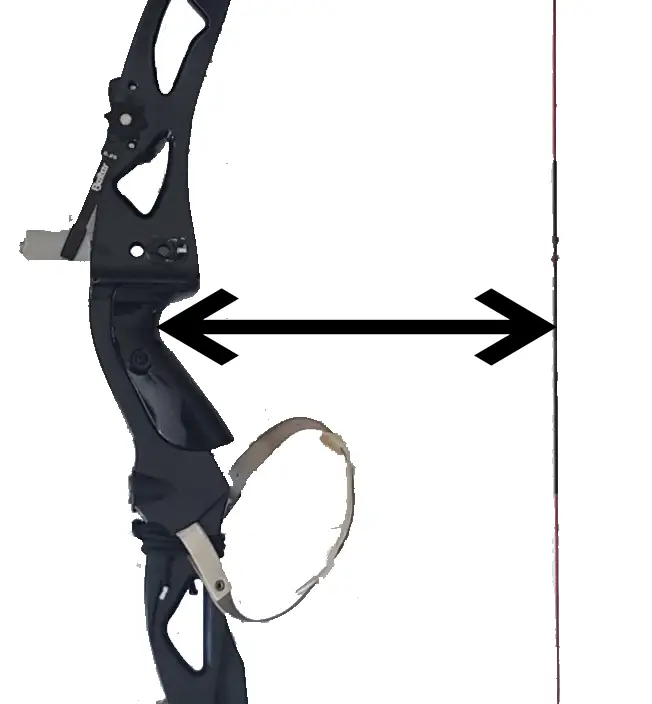
Brace height on recurve bows
Let’s first discuss how brace height works on recurve and traditional bows. In the next section, I will explain how brace height works on compound bows
Adjusting the brace height on recurve bow
To adjust the brace height on a recurve or traditional bow you need to add or remove twists from the string. Adding twists will increase the brace height and removing twists will decrease the brace height
To add or remove twists, you first need to unstring the bow. You need a device called a bowstring, which you attach to the limbs. I recommend this bow stringer because it requires the least strength to use and is safer for the limbs.
You can see how to use a bow stringer in the video below. This video shows how to string a bow. To unstring the bow, you do everything in reverse.
Once the bow is no longer under tension, you simply remove one of the two loops and add or remove some twists.
Making large brace height adjustments
There is only so much you can do with adding and removing twists. Adding or removing more than 20 twists isn’t recommended because that can shorten the lifespan of the string. If the brace height needs to be adjusted an inch (3 cm) or more, it’s better to replace the entire string.
If that is the case, you probably have a string that isn’t a good fit for your bow. You might want to read the article below for tips on how to choose the right string length:
How to choose the right bowstring
Why you should regularly check your brace height
If you shoot at an archery club, you probably see that a lot of archers are checking their brace height before shooting. Recurve strings stretch a lot, especially if they are new. Therefore, it’s recommended to regularly measure your brace height.
If your string is only a few months old, you should check it at least every two weeks. Once your string gets older, you can check it less often. Old strings barely stretch. Still, I would check your brace height every once in a while.
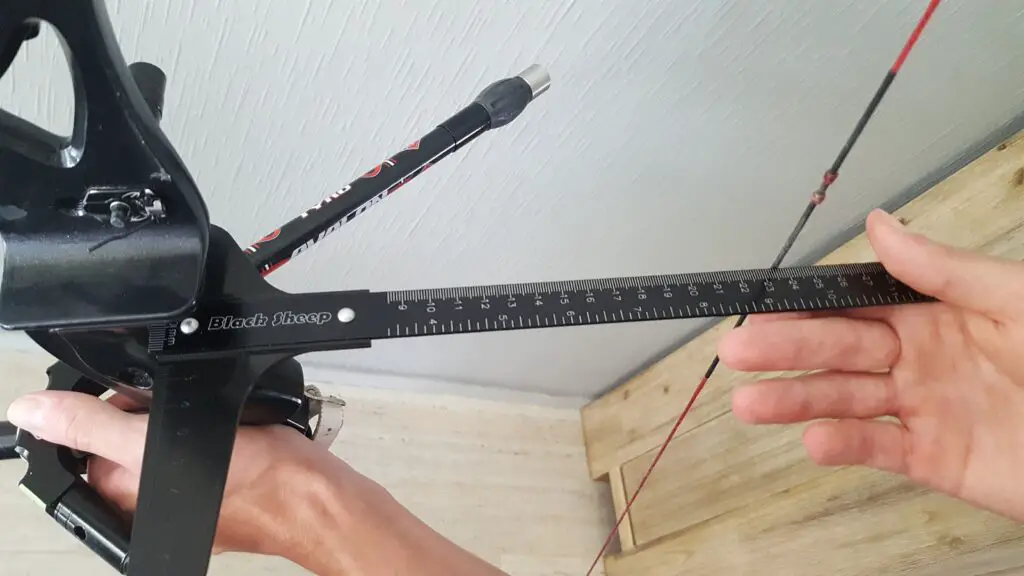
Therefore, make sure to write your brace height down. If you notice that your brace height has decreased, you should add a few twists to get it back to the recommended brace height.
If you notice that your brace height keeps changing even on an old string, you might want to give the article below a read:
Why your brace height keeps changing and how to prevent it
Recommended brace height chart
Most archery manufacturers list their recommended draw weight either on their website or the owner’s manual. It’s always best to use this if you can find it. If that isn’t available, you can use the table below to find the recommended brace height.
| AMO bow length | Minimum brace height | Maximum brace height |
| 58 inches | 7 ¼ inch (18.5 cm) | 7 ¾ inch (19.5 cm) |
| 60 inches | 7 ½ inch (19 cm) | 8 ¼ inch (21 cm) |
| 62 inches | 7 ¾ inch (19.5 cm) | 8 ½ inch (21.5 cm) |
| 64 inches | 8 inch (20.5 cm) | 8 ¾ inch (22 cm) |
| 66 inches | 8 ¼ inch (21 cm) | 9 inch (23 cm) |
| 68 inches | 8 ½ inch (21.5 cm) | 9 ¼ inch (23.5 cm) |
| 70 inches | 8 ¾ inch (22 cm) | 9 ½ inch (24 cm) |
Recommendations from: Lancaster Archery Supply
To use this chart, you need to know your AMO bow length. On most bows, you can find this information printed on the lower limb, near the riser, or the limb fitting of the bow. You can also measure your AMO bow length by following the instructions in the video below.
How your brace height might cause issues
It’s a best practice to keep your bow within the recommended brace height. This will ensure optimal shooting performance and will strain the bow the least. A brace height that is too long will cause the limbs to bend more than they are designed for. This is especially the case if you shoot a heavy draw weight.
Having a too short brace height can also limit your bow’s lifespan. The limbs might spring forward too much which can cause additional strain on the limbs. Additionally, a bow with a too-long brace height can cause hand slap which can be extremely painful.
In most cases, it’s better to have a brace height that is a bit longer than a bit too short. A bow with a long brace height is more forgiving for mistakes of the archer. I discuss how this works in more detail, later in the article.
Brace height on compound bows
Brace height is relatively simple on recurve bows. You simply twist the string to increase or decrease the brace height. Sadly, it isn’t that simple on compound bows. Twisting the string will do little to change the brace height.
Why you can’t adjust the brace height on most compound bows
You can’t change the brace height on most compound bows because most compound bows have parallel limbs. Therefore twisting the string will not increase or decrease the brace height.
Compound technology keeps developing. One recent advancement is the orientation of the limbs. Older compound bows have limbs that were angled at about 45 degrees, similar to recurve bows. Most newer compound bows feature parallel limbs, which means that the limbs are horizontal.
The benefit of parallel limbs is that they vibrate less than angled limbs. Since both limbs move in an opposite direction the vibration will cancel out. I explain how this works in more detail here.
Parallel limbs also have a disadvantage, you can’t change the brace height. On a recurve bow we increase the brace height by twisting the string which will pretense the limbs more. This will cause the limbs to bend backward which causes the brace height to increase.
If we change the tension on parallel limbs, the string and cables will stay in the same position. When the limbs are parallel, they aren’t pulled back, but inwards. Therefore, it’s not possible to change the brace height on these compound bows.
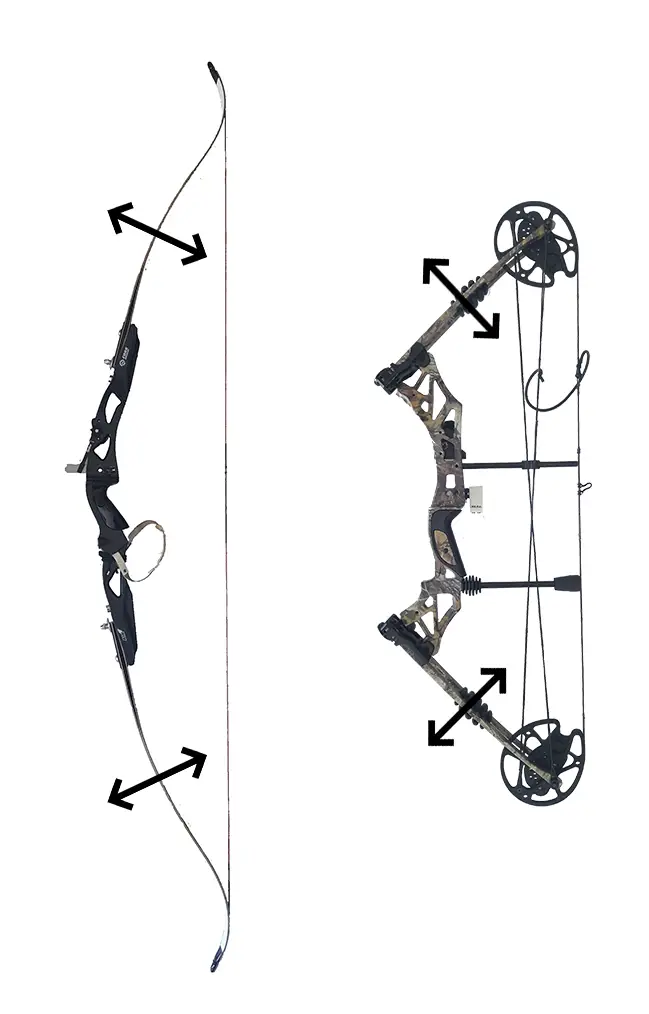
How brace height differs per compound bow
Between different compound bow models, the brace height can vary wildly. This is caused by the shape of the riser. Some compound bows have a straight riser, which causes the brace height to be rather long. Other compound bows have risers that are angled inwards, which will make a shorter brace height.
In general, larger brace heights are more forgiving. Therefore, these are mostly found on target compound bows. Most hunting compound bows feature an angled riser because this increases the arrow speed. I discuss how this works in more detail later in this article.
How brace height differs per compound bow
Between different compound bow models, the brace height can vary wildly. This is caused by the shape of the riser. Some compound bows have a straight riser, which causes the brace height to be rather long. Other compound bows have risers that are angled inwards, which will make a shorter brace height.
In general, larger brace heights are more forgiving. Therefore, these are mostly found on target compound bows. Most hunting compound bows feature an angled riser because this increases the arrow speed. I discuss how this works in more detail later in this article.
Adjusting the brace height on a compound bow
To adjust the brace height on a compound bow, follow these steps:
- Put the bow in a bow press
- Tighten the bow press and remove the tension from the limbs
- Add twists to both cables to increase the brace height and remove twists to decrease it
Make sure to add or remove the same number of twists to both cables, if you have two cables. Otherwise, the cams might shoot out of alignment which can cause your arrow’s flight pattern to change.
Just like a recurve bow, increasing the brace height will also increase the draw weight of the bow. Therefore, be careful and don’t increase the brace height too much. Otherwise, the limbs might be under too much stretch which can decrease their lifespan.
If your want to change the brace height by more than ¼ inch, it’s probably better to buy a new compound bow. Since compound bows are angled more than recurve bows you can’t increase the brace height all that much.
Why brace height is important
Brace height is an important metric because it greatly influences the forgivingness and speed of the arrow. Therefore, you want a consistent brace height that matches your needs in archery.
In this section, I will explain in more detail what exactly the benefits are of these different brace heights.
The benefits of a short brace height
Bows with a short brace height have a higher arrow speed. This is beneficial for almost all archers. It decreases arrow drop, allows you to shoot heavier arrows, and makes the arrow more wind resistant. I discuss the benefits of increasing the arrow speed in more detail in this article.
It might be counter-intuitive that decreasing the brace height increases arrow speed because you do this by decreasing the amount of pre-tension. But if you consider the length of the power stroke it makes a lot of sense.
The power stroke is the amount of draw length the string has to accelerate the arrow. A short power stroke will less efficiently transfer the draw weight to the arrow than a long power stroke. We can calculate the power stroke with the following formula:
‘’Power stroke length = draw length – brace height’’
Therefore, if we keep the draw weight the same but decrease the brace height, we increase the power stroke. On recurve bows, the difference is minor, but on compound bows, this can make a huge difference. That’s why most hunting bows have a short brace height.
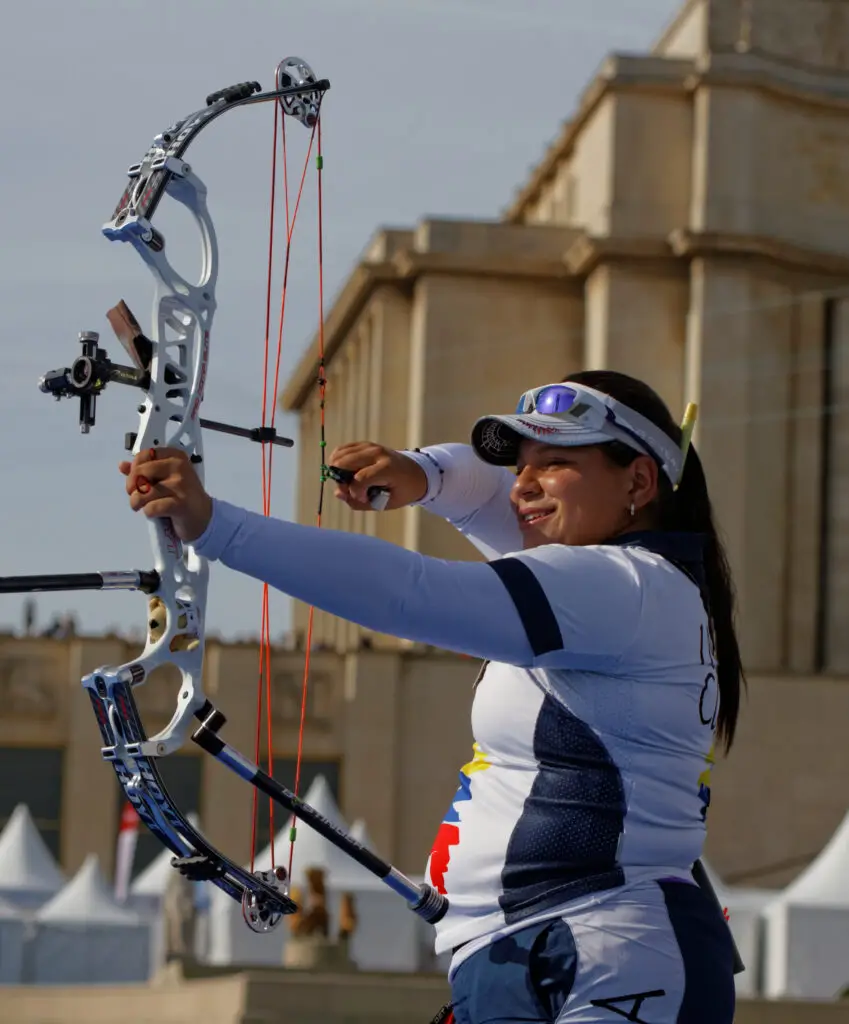
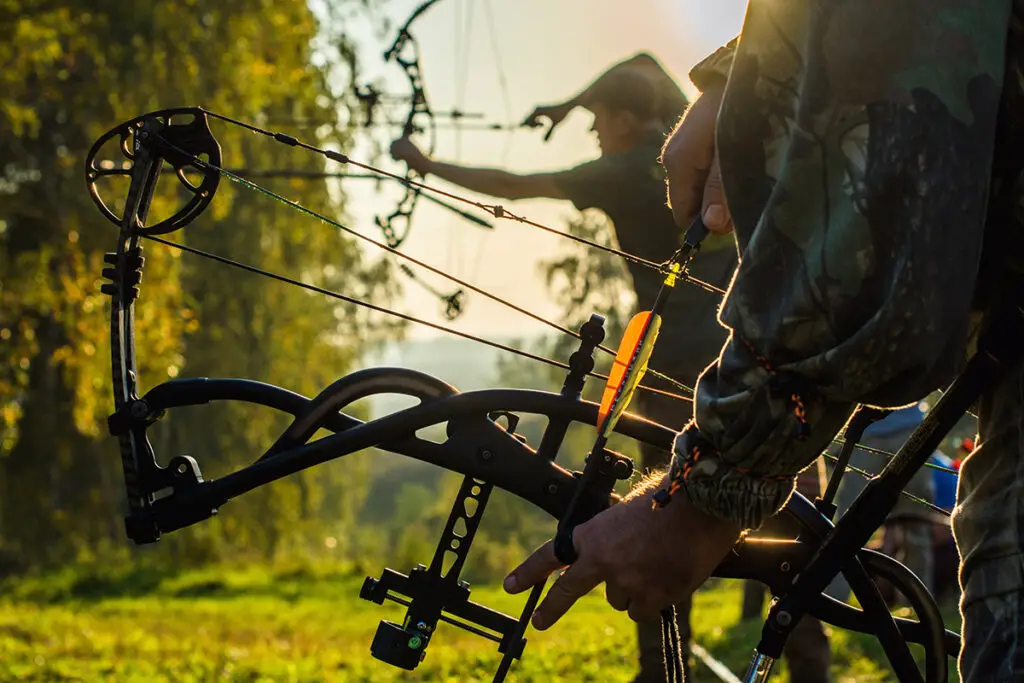
You can easily see the difference between the brace height of the two bows by looking at the risers. The target bow has a straight riser to maximize the brace height. The riser of the hunting bow bends more inwards to decrease the brace height.
The benefits of a long brace height
Having a long brace height also has some important benefits. That’s why target compound bows have a rather long brace height. The longer brace height makes the bow more forgiving because the arrow leaves the string earlier.
A longer power stroke gives the archer more time to flinch or twitch. Therefore, to make a bow as forgiving as possible, you want it to leave the string as early as possible. One of the ways to achieve this is by increasing the brace height.
In the end, it’s all about balancing these two evils. A longer brace height might be more forgiving but also makes it more difficult to shoot the bow at longer ranges and in windy conditions.
Another important benefit of a longer brace height is that you have more clearance with your sleeve. Especially if you frequently shoot during winter, the string might get caught in your sleeve while shooting your bow.
Another common issue with a short brace height is string slap. The string will shoot forward too much which causes it to hit your hand. This is extremely painful and is most likely to happen if you have a long draw length.
For these reasons, beginners should start with a longer brace height. It simply avoids a lot of issues, that are hard to troubleshoot if you’re just getting started.
Learn more about tuning
In this article, we have discussed one part of the bow that can be tuned. But shooting well will still be challenging if your other bow parts are not correctly configured. Therefore, make sure to tune your entire bow by following the guide below:
Also, make sure to read my in-depth articles on tuning the individual bow parts:
Final words
Although I recommend frequently checking your brace height, it’s not worth obsessing over it. When the brace height changes, it will also change the arrow’s flight pattern. But if it’s only a few millimeters, the changes will be very minor.
So don’t spend hours tinkering with your brace height it’s not worth your time. Just use the recommended brace height and keep it consistent. Time spent working on your bow is better spent practicing!
If you have any questions, comments, or remarks; please leave them down below. I will respond to any comments as soon as possible and I will send you an email with my reply.
Tim van Rooijen
For as long as I can remember, I have always been fascinated by archery. First due to its historic significance but later because I like being outdoors. With this blog, I share my knowledge about Archery and how you can improve your shot. More about author…



OK, how about changing axle to axle if out of specs by 1/4″?
Hi Rick,
You can decrease the axle to axle length by shortening the cables of your compound bow, this increases the amount of pre-tension on the limbs. Therefore, you can decrease the axle to axle length by adding twists to your cables. For large, adjustments you might have to replace the cable altogether, but for 1/4 inch you should be able to fix it by adding some twists to the cable.
So, one does not twist or untwist the bowstring at all, just the cables?
My old high-school headmaster was Adriaan van Rooijen. If you live in an English-speaking country, the English (that’s Americans, British, Australians, Canadians, etc., they all talk English) will butcher the pronunciation of your surname.
My brace height must be about 1/8″ longer and the axle to axle just more than 1/4″ shorter.
Hi Chris,
If you want to change your brace height you should only twist or untwist the cables. You can add or remove twists of the bowstring to fine-tune your draw weight, I explain how this works in more detail in this article: https://improveyourarchery.com/how-to-adjust-the-draw-length-of-a-compound-bow/
Although I don’t live in an English-speaking country, I work for an international company, so my surname often gets butchered, but I am used to it. Luckily I have an easy first name 😉